Exploring the majestic kingdom of Bhutan offers a treasure trove of activities that cater to all types of travelers. From the breathtaking Tiger's Nest Monastery to the serene valleys of Punakha, Bhutan is a land that promises adventure, peace, and spiritual enrichment. Whether you are an avid trekker looking to traverse through some of the most beautiful Bhutan hiking trails, a culture enthusiast eager to delve into Bhutanese traditions during vibrant Bhutan festivals, or a nature lover keen to witness the rich wildlife in Bhutan, there’s something here for everyone. Discover the top Things to do in Bhutan through our expertly guided tours, which include cultural immersions, culinary experiences, and spiritual retreats. Prepare to be enchanted by the beauty, culture, and mystery of this Himalayan kingdom.
At Amen Bhutan Tours and Treks, we pride ourselves on being the premier choice for discovering the myriad of Things to do in Bhutan. Our expertly crafted tours are designed to showcase the best of Bhutan's stunning landscapes, rich culture, and unique traditions. From exhilarating treks across pristine mountain trails to immersive cultural experiences and serene spiritual retreats, our offerings are tailored to ensure every traveler finds their perfect adventure. Trust us to guide you through Bhutan’s hidden gems with our deep local knowledge and commitment to providing exceptional service, making your journey unforgettable.
Trek to the Tiger's Nest Monastery
Trekking to the Tiger's Nest Monastery, also known as Paro Taktsang, is arguably the most iconic and spiritually enriching activity among the Things to Do in Bhutan. Perched on the side of a cliff 900 meters above the Paro Valley floor, this sacred site offers breathtaking views and a profound sense of peace.
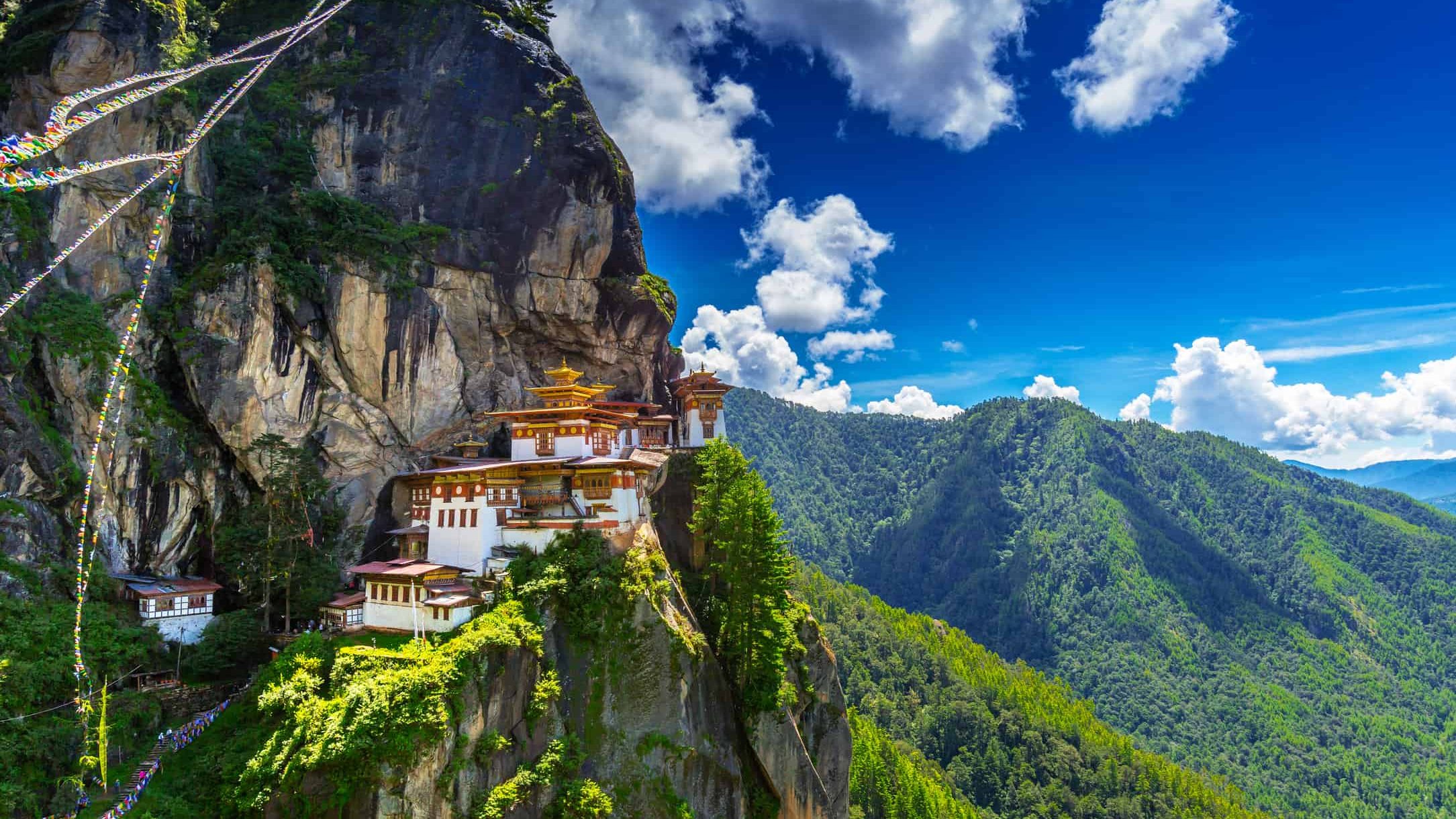
Overview of the Trek: The journey begins in the base town of Paro, where you'll follow a well-marked path through beautiful pine forests dotted with Spanish moss and an occasional prayer flag fluttering in the wind. The trek to Tiger's Nest is about 4 to 6 hours round trip, depending on your pace.
What to Expect: As you ascend, you'll encounter several smaller temples and viewpoints, each offering a unique perspective of the monastery perched seemingly precariously against the cliff face. The path includes a mix of steep climbs and more moderate stretches, with plenty of stops where tea houses invite you to rest and refuel.
Highlights: Upon reaching the monastery, the real reward is both the panoramic views and the serene ambiance of the temple complex. Visitors are often struck by the architectural marvel of the monastery, built directly into the rock face. Inside, you can explore several temples and shrines, each adorned with intricate paintings and statues that are integral to Bhutanese Buddhism.
Best Time to Visit: The best time for this trek is during the spring (March to May) and autumn (September to November) when the weather is clear and the views are unobstructed. These seasons also coincide with several local festivals, adding a cultural element to your visit.
This trek not only challenges your physical stamina but also offers a chance to reflect and meditate in one of the world’s most extraordinary settings. For many, reaching the Tiger's Nest Monastery is a once-in-a-lifetime experience that epitomizes the mystical allure of Bhutan.
Attend a Tshechu Festival
Attending a Tshechu Festival is a highlight among the Things to Do in Bhutan, providing a vibrant insight into the spiritual and cultural life of the Bhutanese people. These festivals are celebrated annually in various monasteries, temples, and dzongs across the country, with each locality hosting its own distinct festivities.
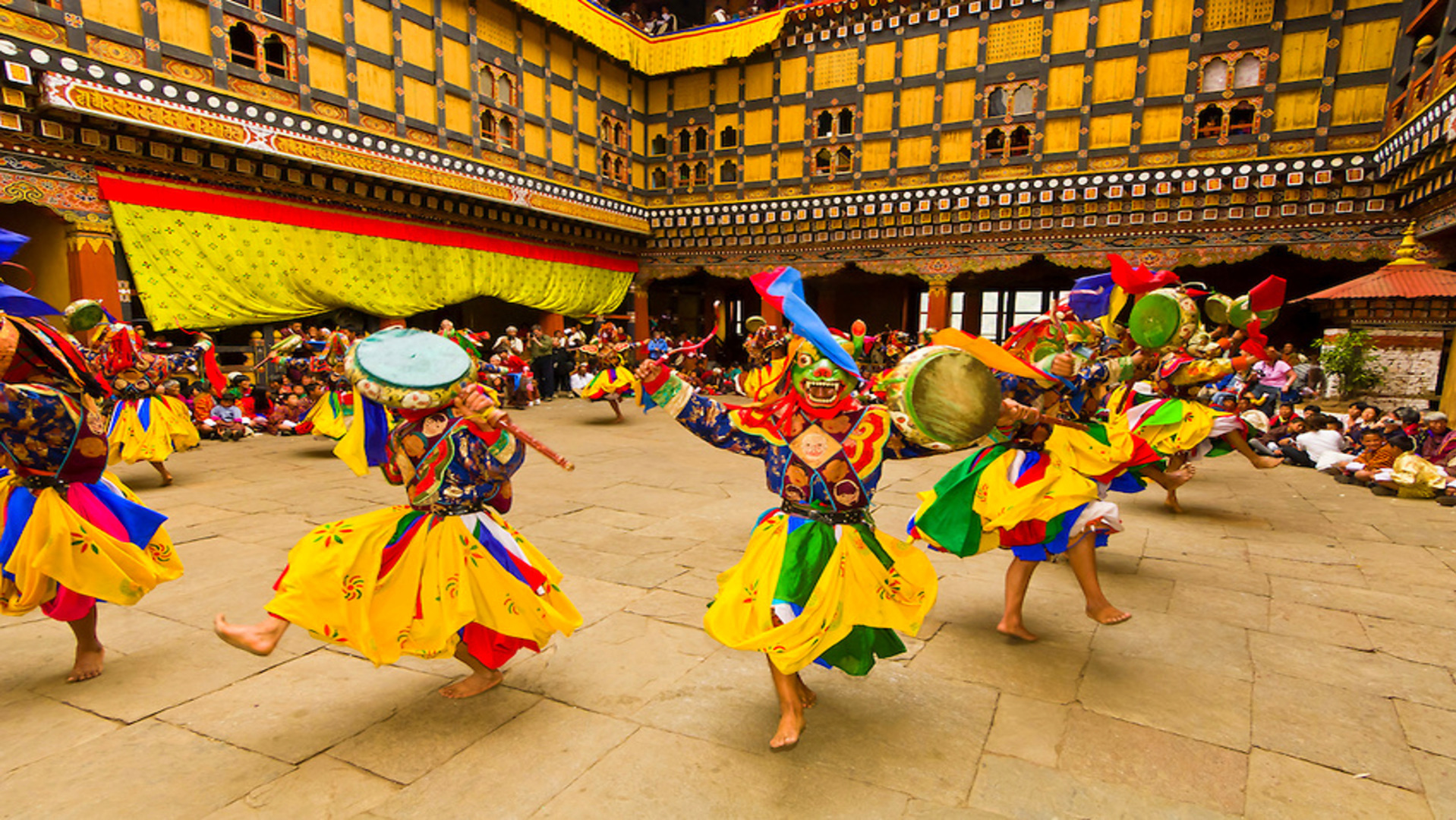
Overview of Tshechu Festivals: Tshechu, which means "tenth day," is held on the tenth day of a month of the lunar Tibetan calendar, corresponding to various months of the Gregorian calendar. The festivals are dedicated to Guru Rinpoche (Padmasambhava), who brought Buddhism to Bhutan in the 8th century. The celebrations are a mix of religious ceremonies, masked dances (Cham dances), and local social gatherings.
What to Expect: Each Tshechu is a colorful affair, where monks and laymen perform elaborate masked dances. These dances are more than just cultural expressions; they are spiritual enactments of ancient Buddhist stories and teachings, designed to impart moral lessons and ward off evil spirits. The dancers wear elaborate costumes and masks representing deities, animals, or historical figures.
Highlights
- Masked Dances: The Cham dances are the heart of any Tshechu, each with its own set of characters and narratives. The dances are believed to bring blessings to the observers as well as instruct them in the teachings of Buddhism.
- Atsara (Clown) Performances: Atsaras, wearing unique masks and often behaving mischievously, add humor and satire to the festivals, engaging with the crowd and keeping the atmosphere light.
- Religious Exhibitions: Large thangkas (religious paintings), known as Thongdrels, are unfurled at dawn on the final day, providing a blessing to the community. Viewing these sacred artworks is considered a once-in-a-lifetime opportunity to gain merits.
- Local Delicacies: Enjoy traditional Bhutanese food and drinks that are plentiful during festival times, giving you a taste of the local cuisine.
- Community Interaction: Tshechus are a social event where families come together, dressed in their finest traditional attire, fostering a sense of community and celebration.
Best Time to Visit: The Paro Tshechu in spring and the Thimphu Tshechu in fall are among the most famous and widely attended festivals, attracting both locals and tourists. These festivals not only showcase the rich cultural heritage of Bhutan but also coincide with the best weather conditions for travel.
Attending a Tshechu Festival offers a profound glimpse into the spiritual depth and artistic heritage of Bhutan, making it an essential experience for anyone visiting this unique country.
Explore Paro Valley
Exploring Paro Valley stands out as a top highlight among the Things to Do in Bhutan. This picturesque region, nestled in the heart of Bhutan, is not only a feast for the eyes with its lush landscapes and traditional architecture but also a hub of cultural history.
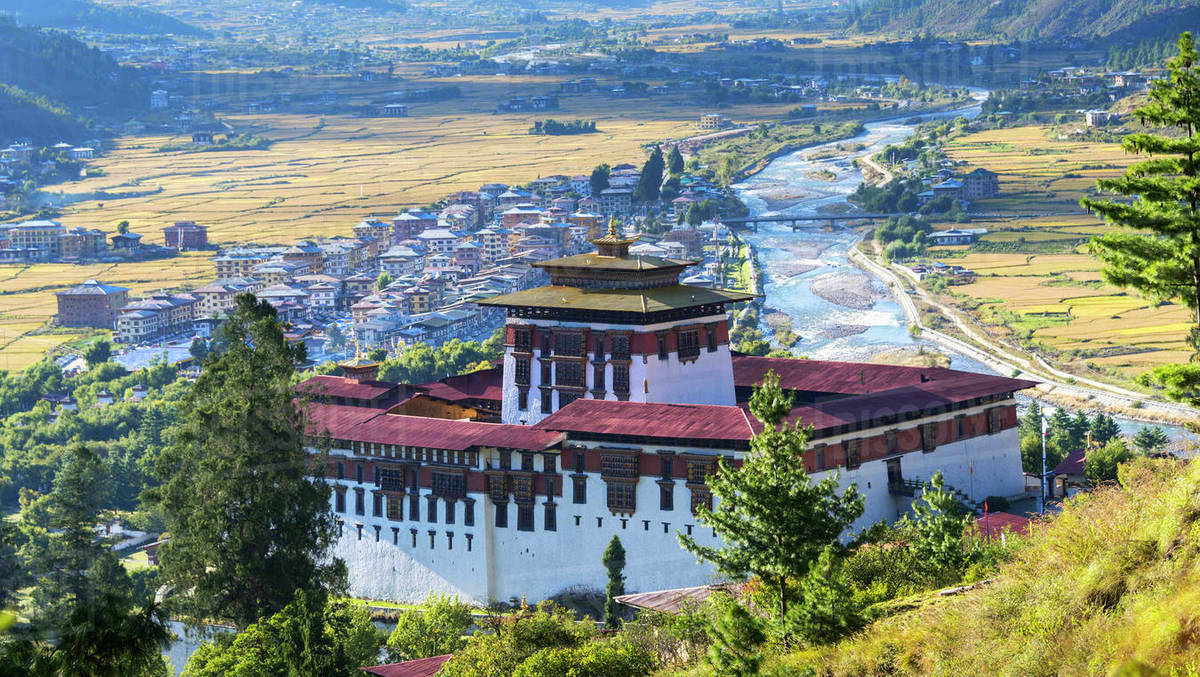
Overview of Paro Valley: Paro Valley is renowned for its verdant and broad expanse surrounded by rugged mountains adorned with ancient watchtowers and monasteries. It serves as an excellent introduction to Bhutan, housing the only international airport in the country.
What to Expect: The valley is dotted with significant historical and spiritual sites, each telling a story of Bhutan's past and present. Here, you'll find a blend of Bhutanese tradition and modernity coexisting harmoniously.
Highlights
- Tiger's Nest Monastery (Taktsang Lhakhang): Perched on a cliff about 900 meters above the valley, this iconic site is accessible via a memorable trek, offering stunning views and a peek into the spiritual heritage of Bhutan.
- Rinpung Dzong: Known as Paro Dzong, this fortress serves both as a religious and administrative center. It's an excellent example of Bhutanese architecture and offers insight into the Bhutanese way of governing.
- National Museum of Bhutan: Housed in an old watchtower above the Rinpung Dzong, the museum showcases a rich array of Bhutanese artifacts that provide a deep dive into the country’s culture and history.
- Drukgyel Dzong: Although largely in ruins, this historic dzong offers picturesque views and tales of Bhutanese warriors.
- Kyichu Lhakhang: One of the oldest temples in Bhutan, dating back to the 7th century, it holds profound spiritual significance and is a must-visit for those interested in the origins of Buddhism in Bhutan.
Local Experiences
- Archery Competitions: Witness Bhutan's national sport at local archery grounds. The sport offers a lively atmosphere where you can observe traditional music, dance, and camaraderie.
- Farmhouse Visit: Experience Bhutanese lifestyle firsthand by visiting a traditional farmhouse. Many offer overnight stays, traditional baths, and homemade meals.
- Shopping: Paro’s main street features traditional Bhutanese shops selling everything from handicrafts to locally produced goods. It’s perfect for picking up souvenirs like hand-woven textiles and wooden masks.
Best Time to Visit: Spring (March to May) and autumn (September to November) are ideal for visiting Paro Valley, as the weather is pleasant with minimal rain, and the skies are generally clear, offering the best views of the majestic Himalayas.
Paro Valley is not just a destination but a gateway to the rich cultural tapestry and breathtaking natural beauty of Bhutan. Whether you're an adventurer, a history enthusiast, or a spiritual seeker, Paro offers a memorable and enriching experience that captures the essence of Bhutan.
Visit Punakha Dzong
Visiting Punakha Dzong is a must-do activity when exploring the rich cultural tapestry of Bhutan. Known as one of the most beautiful and significant dzongs in the country, Punakha Dzong serves as a symbol of unity and religious importance.

Overview of Punakha Dzong: Punakha Dzong, also known as Pungthang Dewachen Phodrang (Palace of Great Happiness), is situated at the confluence of the Pho Chhu (Father River) and Mo Chhu (Mother River). Built in 1637 by Zhabdrung Ngawang Namgyal, the dzong is an architectural marvel, showcasing the skill and artistry of Bhutanese craftsmen.
What to Expect: The dzong's location is as strategic as it is scenic, positioned at the junction of two major rivers, making it a stunning sight, especially during the spring when the lilac-colored jacaranda trees are in bloom. It's the winter home of the Central Monastic Body, which moves there from Thimphu's Tashichho Dzong.
Highlights
- Architectural Grandeur: The dzong’s structure is a fine example of Bhutanese architecture with its intricate woodwork and beautiful courtyards which host several important administrative and religious ceremonies.
- Sacred Relics: Inside, the dzong houses many sacred relics from the days when successive kings reigned over the kingdom.
- Machhen Lhakhang: This temple within the dzong contains the preserved remains of Zhabdrung Ngawang Namgyal and a replica of the precious relic, Rangjung Kharsapani.
- Annual Festivals: Punakha Dzong is the venue for the Punakha Tshechu, a festival that attracts both locals and tourists who come to witness the re-enactment of Bhutanese battles and spiritual teachings through dance.
Local Experiences
- River Rafting: For the adventurous, the rivers around Punakha offer thrilling white-water rafting opportunities.
- Suspension Bridge: Nearby, one of the longest suspension bridges in Bhutan spans the Pho Chhu and offers picturesque views of the valley.
- Hiking: Several trails around Punakha provide opportunities for pleasant walks with great views of the rivers and the valley.
Best Time to Visit: The best time to visit Punakha Dzong is in the spring (March to May) when the weather is warm and the jacaranda trees are in full bloom. Visiting during the Punakha Tshechu (usually in February or March) can also be particularly rewarding, offering a glimpse into the spiritual and cultural life of the Bhutanese people.
Punakha Dzong is not just an architectural wonder but a living piece of Bhutanese history and spirituality, making it a profound and picturesque experience for all who visit.
Archery and Dart Competitions
Attending or participating in archery and dart competitions ranks high among the Things to Do in Bhutan, offering visitors a unique glimpse into the national sports of this Himalayan kingdom. Archery, the national sport of Bhutan, is deeply ingrained in the culture, providing not just entertainment but also a festive atmosphere where communities come together.
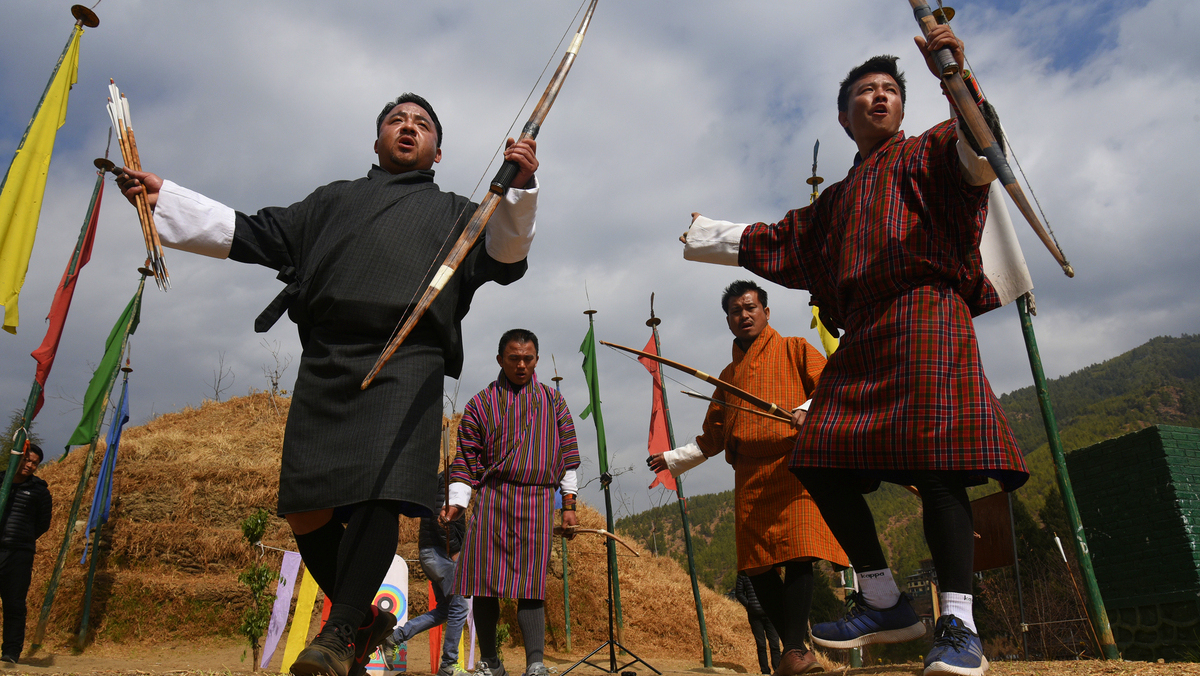
Overview of Archery in Bhutan: Archery competitions in Bhutan are vibrant and colorful events, where teams from different regions or villages compete in a display of skill and camaraderie. These competitions are often accompanied by traditional music, dancing, and a fair amount of good-natured taunting and jesting among competitors.
What to Expect: The archery range is usually set up over a long distance, typically about 145 meters apart. The targets are relatively small, making the sport highly challenging and exciting to watch. Archers use traditional bamboo bows or modern compound bows, and the competition is as much a social occasion as it is a sporting event.
Highlights of Bhutanese Archery
- Festive Atmosphere: The competitions are lively, with teams dressed in traditional attire. Spectators and team members often burst into song or dance to celebrate a good shot or to distract the opposition.
- Precision and Skill: Watching the archers’ precision and skill can be mesmerizing. Hitting the small target from such a distance requires not just physical ability but also intense concentration and practice.
- Cultural Significance: Archery in Bhutan is more than just a sport; it's a cultural heritage that fosters social bonds and community spirit.
Overview of Dart Competitions: Dart competitions, known locally as Khuru, are also popular and involve throwing wooden darts at a target about 20 meters away. These games are usually played alongside archery tournaments and feature a lot of the same festive elements.
What to Expect from Dart Competitions
- Community Participation: Like archery, darts are a communal activity with participants cheering each other on amidst a lot of laughter and banter.
- Skill Display: The game requires skill and precision, and hitting the target can be quite challenging, adding to the excitement for players and spectators alike.
Best Time to Experience: Archery and dart competitions can be observed throughout the year, especially during local festivals and public holidays. However, the largest tournaments are often held around the time of major festivals like the Tshechu, which take place in different regions at various times of the year.
Experiencing these traditional sports provides not just entertainment but also a deeper understanding of the Bhutanese way of life, making it a fascinating aspect of any trip to Bhutan.
Bhutanese Cuisine Tasting
Tasting Bhutanese cuisine is an essential experience for any visitor and a delightful entry on the list of Things to Do in Bhutan. The country’s food is a fascinating blend of Indian, Tibetan, and Chinese influences, yet it holds its unique flavors and techniques, with a notable emphasis on fiery chilies and the ubiquitous cheese.
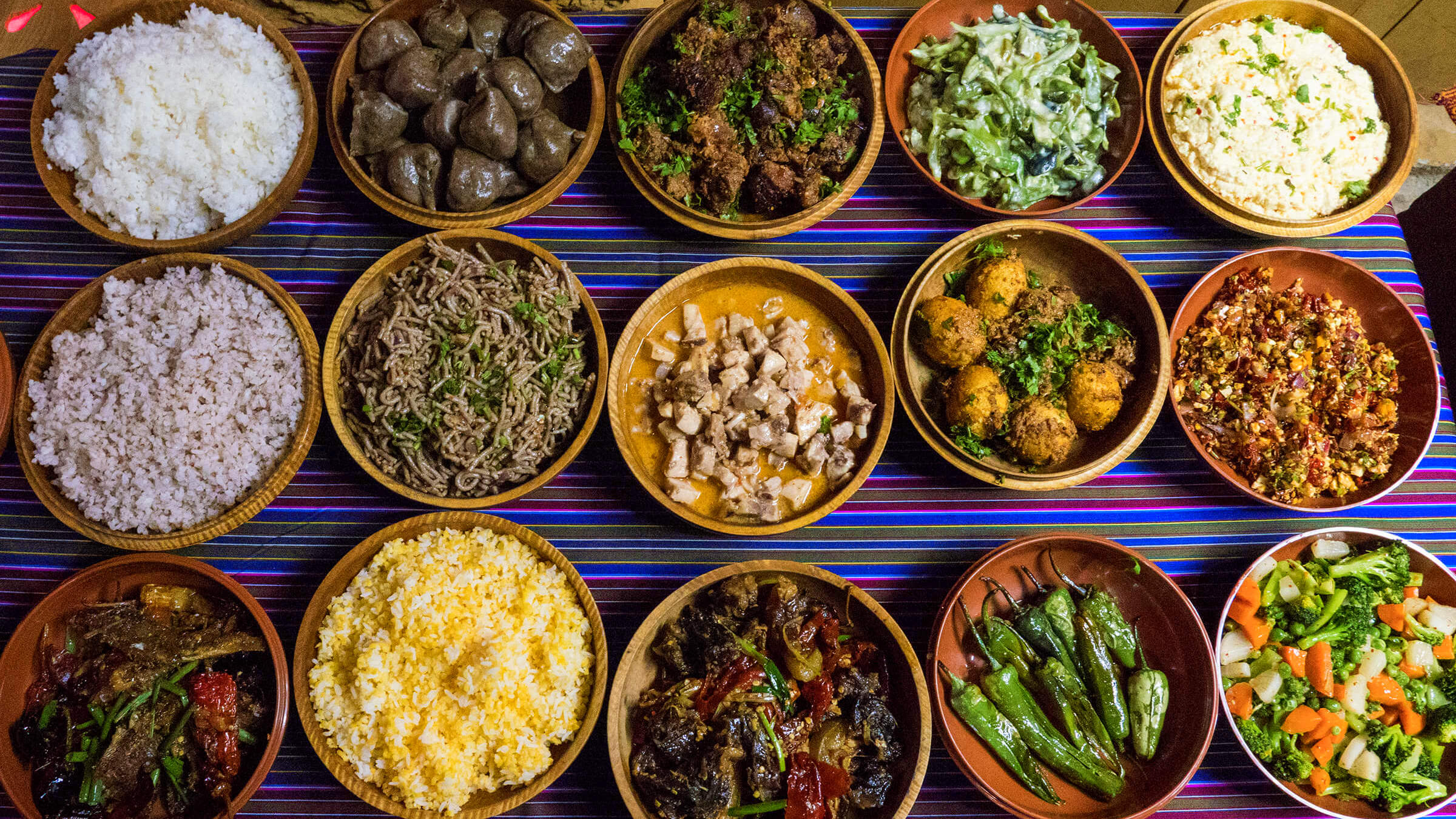
Overview of Bhutanese Cuisine: Bhutanese dishes are known for their spiciness. Most meals feature generous amounts of chili and are often tempered with cheese, which is a staple ingredient. The cuisine is also characterized by its use of fresh, locally sourced ingredients, including a variety of meats, rice, and vegetables.
What to Expect: When you dive into Bhutanese cuisine, expect a palate that balances spicy, savory, and sometimes bitter flavors. The food is hearty, often accompanied by red rice, which is a Bhutanese staple.
Highlights of Bhutanese Cuisine
- Ema Datshi: This is the national dish of Bhutan, made with spicy chilies (ema) and local cheese (datshi). It can be prepared with green, red, or yellow chilies, making it a versatile dish that appears in almost every meal.
- Momos: These Tibetan-style dumplings are popular in Bhutan as well. They are stuffed with either meat or vegetables and are a must-try for their delicious, juicy fillings.
- Phaksha Paa: A pork dish cooked with spicy red chilies and sometimes mixed with radishes or spinach.
- Jasha Maroo: A spicy chicken stew, this dish is cooked with ginger, garlic, and onions, and is often served with rice.
- Red Rice: A nutty-flavored rice that is a dietary staple in Bhutan. It is more nutritious than white rice and is often served as a side with various dishes.
Local Beverages
- Suja: Also known as butter tea, it’s a blend of tea leaves, water, salt, and butter. It’s an acquired taste but is a central part of Bhutanese hospitality.
- Ara: A traditional alcoholic beverage made from rice, maize, millet, or wheat and usually served warm.
Best Time for Culinary Exploration: Bhutanese cuisine can be enjoyed year-round, but visiting during local festivals can provide an even greater array of dishes and specialties that are not commonly available at other times.
Diving into the flavors of Bhutan is not just about feeding the body but also about understanding the culture and traditions that shape this unique culinary landscape. Whether it’s the fiery ema datshi or the comforting momos, each dish tells a story of Bhutan’s rich culinary heritage.
Scenic Drives through Bhutan
Embarking on scenic drives through Bhutan offers a wonderful way to witness the country's diverse landscapes, from lush valleys and quaint villages to majestic mountain ranges. These drives rank highly among the Things to Do in Bhutan, allowing travelers to immerse themselves in Bhutan's natural beauty and cultural richness at a leisurely pace.
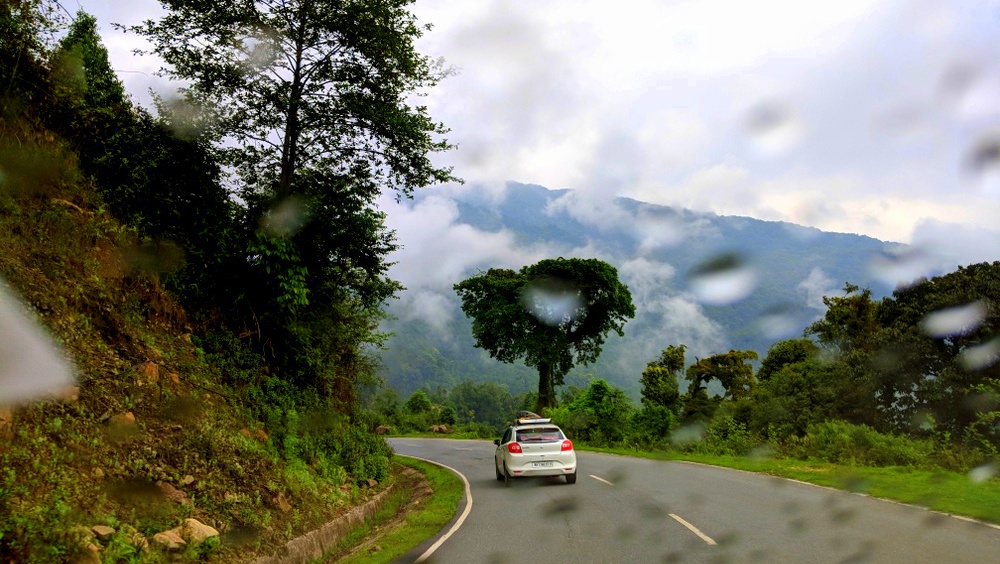
Overview of Scenic Drives in Bhutan: Bhutan's roads wind through some of the most breathtaking scenery on the planet. From the hairpin turns of mountain passes adorned with fluttering prayer flags to the expansive views of terraced rice fields, each drive presents its own set of stunning visuals and experiences.
What to Expect: Driving in Bhutan can be an adventure due to its mountainous terrain and winding roads. The journeys, although often long and slow due to road conditions, are incredibly scenic and provide numerous opportunities for photography and stops at local attractions.
Highlights of Scenic Drives in Bhutan
- Thimphu to Paro: This short drive takes you through a well-maintained road offering views of the Thimphu river and rice fields, with opportunities to stop at traditional Bhutanese villages.
- Paro to Haa Valley via Chele La Pass: At 3,988 meters, Chele La is one of the highest motorable passes in Bhutan, offering panoramic views of sacred mountains Jomolhari and Jichu Drake. The pass is also a wonderful spot for photography, especially when the rhododendrons bloom.
- Thimphu to Punakha: This route crosses the Dochu La Pass, where on a clear day, one can see a breathtaking 360-degree panoramic view of the Himalayan mountain range. The pass is also famous for its 108 chortens, built as a memorial by the Queen Mother.
- Bumthang to Mongar: This drive is part of the journey from the western to the eastern part of Bhutan, showcasing a transition in flora and cultural life. The journey takes you through Ura valley and Thrumshing La, Bhutan’s second-highest pass.
Local Experiences
- Dochu La Pass: On the drive from Thimphu to Punakha, stop at the Dochu La Pass to visit the Druk Wangyal Chortens and take in the expansive views of the Eastern Himalayas.
- Yotong La Pass: Crossing this pass while driving from Trongsa to Bumthang is memorable for its beautiful landscapes and the dramatic change in vegetation from alpine to subtropical.
- Photography Stops: Bhutan’s roads are lined with scenic spots perfect for photography, from sweeping vistas to close-up shots of flora and traditional architecture.
Best Time for Scenic Drives: The best times for scenic drives in Bhutan are during the spring (March to May) and autumn (September to November) months when the skies are clear, and the views are unobstructed by clouds.
Scenic drives in Bhutan are not just about reaching a destination; they are an integral part of the travel experience, offering a way to connect deeply with the landscape and culture of this unique country.
Wildlife Watching
Wildlife watching is a captivating and essential activity for nature enthusiasts visiting Bhutan. This Himalayan kingdom, with its vast and varied ecosystems, provides sanctuary to a diverse range of flora and fauna, some of which are endemic to the region. Engaging in wildlife watching here not only brings you closer to nature but also helps appreciate Bhutan’s conservation efforts.
.jpg)
Overview of Wildlife in Bhutan: Bhutan’s commitment to maintaining at least 60% of its land under forest cover for all time has led to the preservation of many unique ecosystems. These range from subtropical plains in the south to temperate forests in the mid-regions and alpine zones in the north. Each habitat supports a rich biodiversity, including several rare and endangered species.
What to Expect: When you set out for wildlife watching in Bhutan, expect to explore national parks, wildlife sanctuaries, and protected areas that are relatively untouched by human activity. The experience can be both thrilling and serene, as you venture into dense forests and remote areas.
Highlights of Wildlife Watching in Bhutan
- Jigme Dorji National Park: This is one of the largest protected areas in Bhutan, home to the elusive snow leopard, Bengal tiger, blue sheep, and the takin (Bhutan’s national animal).
- Royal Manas National Park: Known as the conservation showpiece of the Kingdom and a biodiversity hotspot, it hosts tigers, elephants, rhinos, and the rare golden langur.
- Bumdeling Wildlife Sanctuary: An important habitat for the black-necked crane, which migrates here from the Tibetan Plateau in the winter.
- Phobjikha Valley: A stunning glacial valley that serves as a winter home for the black-necked cranes.
Local Experiences
- Community involvement: Some wildlife tours contribute to local communities and conservation efforts, providing a more sustainable approach to wildlife tourism.
- Cultural integration: Wildlife tours often include elements of local culture, such as visits to nearby villages or talks on Bhutanese environmental philosophy.
Ethical Considerations: When participating in wildlife watching, it’s important to choose tours that prioritize the well-being of the wildlife and the environment. Bhutan’s approach to tourism and conservation involves strict guidelines to minimize the impact on the natural world, aligning with their broader commitment to Gross National Happiness and environmental conservation.
Best Time to Visit: The best times for wildlife watching are during the spring and autumn months when the weather is pleasant, and the animals are more active.
Wildlife watching in Bhutan is not just an activity; it’s an immersion into the heart of what makes Bhutan a truly unique country — its pristine nature and the harmonious coexistence of humans and wildlife.
Cultural Tours in Thimphu
Cultural tours in Thimphu offer a deep dive into the heart of Bhutanese culture and history, making them a must-do among the Things to Do in Bhutan. As the capital and largest city of Bhutan, Thimphu is a treasure trove of cultural heritage, blending ancient traditions with the modest influences of modernity.
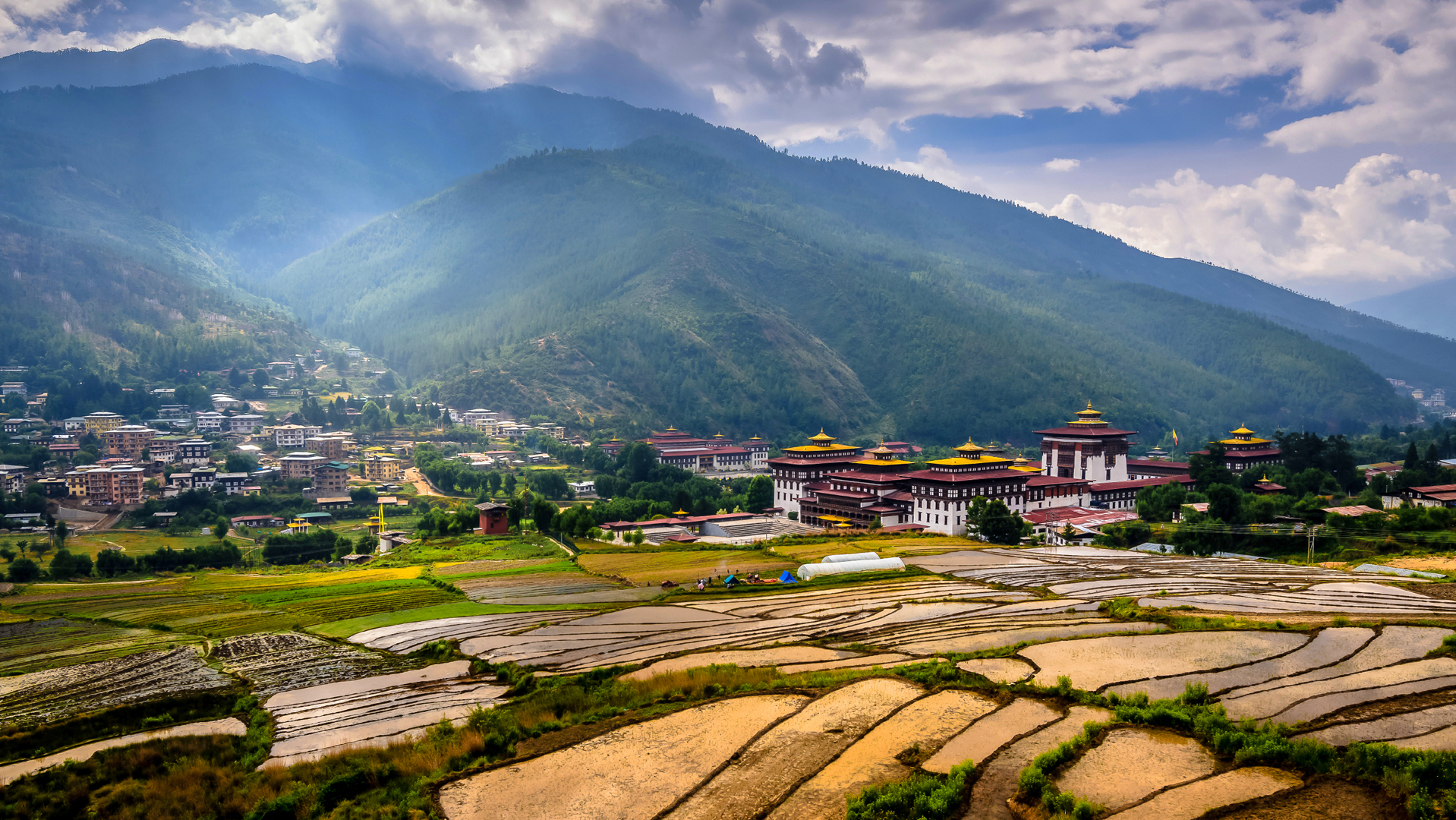
Overview of Cultural Tours in Thimphu: Thimphu, with its unique status as the world's only capital without traffic lights, combines traditional Bhutanese lifestyle with the conveniences of modern living. A cultural tour in Thimphu allows visitors to explore majestic dzongs, monasteries, museums, and markets, each offering insights into the Bhutanese way of life.
What to Expect: Cultural tours in Thimphu can vary widely but generally include visits to key historical and spiritual sites, combined with opportunities to interact with local artisans, monks, and everyday citizens.
Highlights of Cultural Tours in Thimphu
- Tashichho Dzong: This impressive fortress serves as the throne room and office of the King of Bhutan, as well as the seat of the Government. It is also a prominent religious site and opens to visitors when the government is not in session.
- National Memorial Chorten: This stupa was built in memory of the third King of Bhutan and is a focus for daily religious gatherings of the local population, making it a great place to observe spiritual practices.
- Folk Heritage Museum: Housed in a traditional rammed-earth and timber house, this museum offers a glimpse into Bhutanese rural life. It includes displays of household objects, tools, and equipment.
- Buddha Dordenma Statue: One of the largest Buddha statues in the world, located at Kuensel Phodrang. The site offers panoramic views of the Thimphu Valley.
- Textile Museum: Learn about Bhutan’s living national art of weaving. This museum showcases various techniques, styles, and types of Bhutanese textiles and dresses.
- Thimphu Weekend Market: Explore the vibrant local market where the residents come to buy fresh produce, handicrafts, and other goods. It’s a great place to try local foods and observe everyday life.
Best Time for Cultural Tours: The best times to visit Thimphu for cultural tours are during the spring (March to May) and fall (September to November) when the weather is favorable for exploration. Visiting during a local festival, such as the Thimphu Tshechu, can enhance the experience with unique cultural performances and ceremonies.
Local Experiences
- Craft Bazaars: Regular craft bazaars offer a chance to see and buy traditional crafts directly from artisans.
- Monastic Festivals: Participate in or observe local monastic festivals, which are rich in religious symbolism and offer a profound insight into Bhutanese spirituality.
Cultural tours in Thimphu are essential for anyone seeking to understand the depth of Bhutanese culture and history, providing an enriching and educational experience that highlights the traditional and contemporary facets of Bhutanese life.
Hiking and Bird Watching
Hiking and bird watching in Bhutan are activities that offer an enchanting blend of natural exploration and wildlife observation, essential for nature lovers visiting this Himalayan kingdom.

Overview of Hiking and Bird Watching in Bhutan: Bhutan's diverse ecosystems, ranging from subtropical plains to high mountain valleys, provide ideal habitats for a wide range of flora and fauna, including over 670 species of birds. The country’s commitment to environmental conservation ensures that its natural landscapes remain pristine and vibrant, offering exceptional hiking and bird watching opportunities.
What to Expect: Hiking in Bhutan can range from gentle walks through verdant meadows and ancient forests to challenging treks up rugged mountain paths. Bird watching can be integrated into these hikes, providing a rewarding way to combine physical activity with the chance to spot rare and exotic bird species.
Highlights of Hiking and Bird Watching in Bhutan
- Phobjikha Valley: Known for its beautiful landscapes and as a winter home to the rare black-necked cranes. The valley offers easy to moderate hikes alongside opportunities to observe these majestic birds in their natural habitat.
- Jigme Dorji National Park: Offers more strenuous treks and the chance to spot a variety of birds, including the elusive snow leopard for the extremely fortunate. Birds like the Ibisbill and the Tibetan snowcock can often be seen here.
- Bumdeling Wildlife Sanctuary: Another fantastic area for bird enthusiasts, especially during the winter months when the black-necked cranes visit. The area also supports a diverse array of other wildlife.
- Chele La Pass: At an elevation of over 3,800 meters, this pass provides opportunities for both hiking and bird watching, with stunning views. Birds commonly seen here include blood pheasants and Himalayan monals.
Ethical Bird Watching
- Maintain Distance: Always keep a respectful distance from nests and feeding sites to avoid causing stress to the birds.
- Silence is Golden: Keep noise to a minimum to avoid scaring birds away and to increase your chances of sightings.
Local Experiences
- Community involvement: Engage with local communities by staying in village guesthouses or participating in community-led conservation projects.
- Photography: Bhutan’s landscapes provide a stunning backdrop for wildlife photography, but always prioritize the well-being of the wildlife over getting the perfect shot.
Best Time to Visit: Spring (March to May) and autumn (September to November) are the best times for hiking and bird watching, as the weather is mild and birds are more visible.
Hiking and bird watching in Bhutan are not just recreational activities; they are immersive experiences that allow visitors to connect deeply with the natural world. Bhutan’s untouched landscapes, combined with its rich avian diversity, make it a premier destination for nature enthusiasts from around the globe.
Bhutan offers a treasure trove of activities tailored to all types of travelers, combining natural beauty, spiritual depth, and cultural richness. From the challenging treks to iconic monasteries like the Tiger's Nest, to the vibrant festivities of Tshechu festivals, and the tranquil experiences of wildlife watching and scenic drives, Bhutan promises a unique adventure. Each activity not only showcases the country’s stunning landscapes and architectural marvels but also offers a deeper understanding of its profound cultural heritage and commitment to conservation. Whether you’re exploring the serene valleys, participating in traditional sports, or sampling the distinctive flavors of Bhutanese cuisine, Bhutan offers an enriching, soul-stirring journey that stays with you long after you leave.
FAQs of the Things to do in Bhutan
Q: What are the best things to do in Bhutan for first-time visitors?
A: For first-timers, essential activities include visiting the Tiger's Nest Monastery, attending a Tshechu festival, exploring historical dzongs like Punakha Dzong, and enjoying scenic drives and hikes. Sampling traditional Bhutanese cuisine and visiting Thimphu for its cultural sites are also recommended.
Q: How long should I spend in Bhutan to experience its highlights?
A: A minimum of one week is recommended to cover the highlights of Bhutan, allowing for proper acclimatization and a leisurely exploration of major attractions in towns like Paro, Thimphu, and Punakha.
Q: What is the best time of year to visit Bhutan?
A: The best times to visit are during the spring (March to May) and autumn (September to November) when the weather is favorable for outdoor activities and the skies are clear for the best mountain views. These periods also coincide with major cultural festivals.
Q: Are there any specific cultural customs I should be aware of when visiting Bhutan?
A: Yes, it's important to dress modestly, especially in religious places, remove shoes before entering temples, and always seek permission before taking photographs, particularly of people. Politely refuse food at least once before accepting it on the second offer as part of local etiquette.
Q: What kind of budget should I prepare for a trip to Bhutan?
A: Bhutan requires all tourists to pay a minimum daily tariff ranging from $200 to $250 per person, which covers accommodation, transport, food, and a guide. This ensures that all essentials are taken care of, making it easier to manage your budget once in Bhutan.
Q: Can I go trekking in Bhutan if I'm not very experienced?
A: Yes, Bhutan offers treks ranging from easy day hikes to challenging high-altitude adventures. Less experienced hikers can enjoy cultural treks or easier valley trails, while more seasoned trekkers might opt for challenging routes like the Snowman Trek.
Q: Is it easy to find vegetarian food in Bhutan?
A: Yes, there are many vegetarian options available in Bhutanese cuisine, thanks to the Buddhist influence. Many dishes, including the national dish Ema Datshi, can be prepared without meat.
Q: What wildlife can I expect to see in Bhutan?
A: Bhutan's diverse ecosystems are home to animals like Bengal tigers, snow leopards, red pandas, and the unique takin. Birdwatchers can also spot the black-necked crane, hornbills, and many other species.
Q: Do I need a visa to visit Bhutan?
A: All international tourists must obtain a visa before arriving in Bhutan, except for citizens of India, Bangladesh, and the Maldives. Visas are arranged by tour operators as part of the travel package.
Q: What are some tips for responsible tourism in Bhutan?
A: Support local economies by staying in family-run lodges, buying local products, and using local services. Be environmentally conscious by minimizing waste, avoiding plastics, and staying on marked trails during hikes. Follow your guide’s advice to ensure your visit has a positive impact on the local community and environment.
If you are looking for tour packages in Bhutan please click here
If you need any further information, please contact us, Email: at [email protected] , Phone (Whatsapp or Viber) +975-1755-6636
